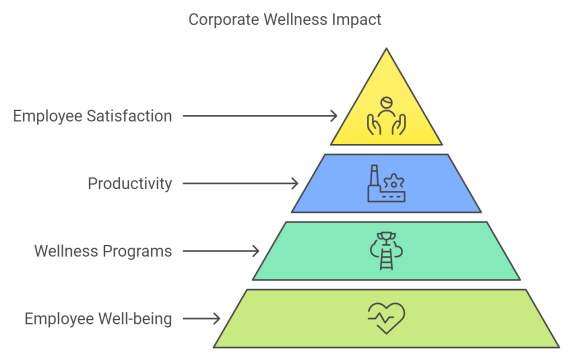Imagine a complex clockwork in which each cog is precisely aligned with the next. If one gets stuck, the entire system comes to a halt. The situation is similar in companies. Healthy and satisfied employees are not only more motivated, but also demonstrably achieve more. A study by Harvard Business Review emphasizes that companies with effective wellness programs see a significant increase in productivity and reduce absenteeism. Every dollar invested in wellness can generate a return of almost three dollars.
At Google, employee well-being is more than just a nice extra—it's part of the company's DNA. Free, healthy meals in the canteens, gyms right at the workplace and mental health programs are a matter of course. These measures have not only increased employee satisfaction, but also kept fluctuation low and increased productivity by 12%.
At Aetna, a US insurance company, they recognized early on how important employee well-being is. Aetna offers its employees free mindfulness and yoga classes. According to CEO Mark Bertolini, this led to an average productivity increase of 62 minutes per employee per week. In addition, the stress levels of those taking part fell by 28%.
Salesforce, a leading cloud computing company, integrates well-being into its corporate culture. With programs such as “Mindfulness Zones” in the offices and regular wellness events, Salesforce promotes the mental health of its employees. The company has been repeatedly recognized as one of the best employers, which indicates a high level of employee satisfaction.
Outdoor outfitter Patagonia goes even further. In addition to flexible working hours, the company offers its on-site employees childcare, fitness classes and even opportunities to surf during the lunch break. This culture of trust and appreciation has led to high loyalty and lower fluctuation.
The positive effects of such initiatives are not only noticeable, but also measurable. According to a study by the American Psychological Association companies with wellness programs have higher employee satisfaction and lower absenteeism. Healthy employees are less susceptible to stress and burnout, which has a direct impact on their performance and the overall performance of the company.
For companies that want to follow a similar path, it all starts with listening. What are the needs and desires of their own employees? Through open communication and surveys, a tailored program can be developed that is truly appreciated. Involving the workforce in this process not only increases acceptance, but also promotes a sense of belonging and value.
A central starting point is to make working conditions more flexible. Whether it's flexible working hours, the option of working from home, or extended break arrangements, measures that take into account the individual lifestyle of employees can have a major impact. In addition to this, offers such as healthy canteen options, fitness memberships, or mental health programs can sustainably increase well-being.

- Keynote with Jan C. Küster: Elevating Corporate Health: Innovations for a Thriving Workplace
🕙 Every day
📍Yellow Stage (Hall B2)
- Panel Talk with Reiner Gerstner and Swen Grauer: Leading (Healthy) Like a Pro: What Business Can Learn From Elite Sport
🕙 Thursday, December 5, 2024 / 2:45 - 3:30 p.m.
📍Main Stage (Hall B2)
- If you want to go a little deeper, the therapie München partner conference will give you deep insights into the latest experiences in the world of therapy and medical rehabilitation.
Do you want to promote well-being in your office? Then find out how to make your office happy and increase productivity at ISPO Munich 2024.
ISPO has always been committed to promoting health and well-being. By connecting companies and sharing best practices, it helps organizations implement effective wellness programs. This commitment helps create a working environment in which people can reach their full potential – to the benefit of all involved.
Investing in employee well-being is more than just social responsibility; it is a strategic decision with tangible benefits. In an era when the battle for the best talent is becoming increasingly intense, such programs can make all the difference. They not only increase an employer's attractiveness, but also promote a culture of appreciation and respect.
In the end, everyone benefits: employees feel seen and valued, which increases their satisfaction and loyalty. Companies themselves see higher productivity, lower absenteeism and stronger retention of their talent.

- ISPO awards
- Mountain sports
- Bike
- Design
- Retail
- Fitness
- Health
- ISPO Job Market
- ISPO Munich
- ISPO Shanghai
- Running
- Brands
- Sustainability
- Olympia
- OutDoor
- Promotion
- Sports Business
- ISPO Textrends
- Triathlon
- Water sports
- Winter sports
- eSports
- SportsTech
- OutDoor by ISPO
- Heroes
- Transformation
- Sport Fashion
- Urban Culture
- Challenges of a CEO
- Trade fairs
- Sports
- Find the Balance
- Product reviews
- Newsletter Exclusive Area
- Magazine





